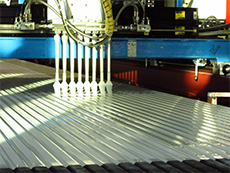A sticky situation resolved
 |
The glue dispensing machine runs the length of each NOvA detector module, coating it with slow-drying glue as it goes. Photo: William Miller, NOvA installation manager
|
“Life in plastic. It’s fantastic!” sang the dance-pop band Aqua first in 1997 as tribute to Barbie and her perfect plastic world. The 5,000 tons of plastic that make up NOvA’s near and far detectors put any of Barbie’s plastic palaces to shame, both in size and strength. Sorry, Barbie.
The far detector, the larger of the two detectors, will consist of 28 so-called blocks, and on Oct. 25 scientists erected the third. Each block is made from 768 pieces of polyvinyl chloride plastic, which scientists glue together. The result is a five-story-tall and equally wide block of plastic.
Such a profusion of plastic takes more than superglue to keep intact for the detector’s lifetime. Fermilab looked to adhesive technology and product distributor ITW Devcon, based in Danvers, Mass., to design the glue with the best grip.
As Devcon’s business manager of new product development Dave Bongiorni put it, “all was good in the land of goo” until early this year. That’s when Fermilab and Devcon discovered that the glue wasn’t biting into the plastic like it had in earlier tests.
To identify the problem, Devcon chemists set out for Ash River, Minn. where scientists assemble the detector.
“It’s not often you run into a manufacturer that goes out of their way to come find you to see if their product is okay,” said John Cooper, NOvA project manager. “It’s usually the other way around for us. Devcon did really nice work.”
Within three months Devcon had identified the problem, modified the glue formula, and presented Fermilab with two new glues to test.
The problem stemmed from a change in Fermilab’s plastic production method midway through construction. By increasing the temperature slightly in order to produce a stronger product faster, Fermilab scientists had also made the plastic smoother and shinier. The new plastic surface eluded the old Devcon glue’s grip.
“It’s like if you took a cake batter and you say, ‘Let’s just cook it at a little higher temperature for a shorter time,’” Cooper said. “You don’t get a cake is the problem.”
Now scientists are applying to the plastic one of the two new glues Devcon offered. When complete, the experiment will have used up about 40,000 gallons of glue.
“Solving the problem was a concerted effort between chemists and physicists,” Bongiorni said.
The glue itself can be used for other products, Bongiorni said. One quality that contributes to its uniqueness is its considerably long "open time.” That means that, once dispensed onto a surface, it will take between 11 and 18 minutes to dry.
NOvA’s blocks need this lengthy drying time because each detector module that scientists install to make a block is about 52 feet long by four feet wide. That amount of surface area takes time to coat.
Luckily the glue’s toxicity concentrations are low so workers can stand ready to sandwich two layers together when the glue-dispensing machine is finished. There’s just one minor drawback to this aggressive adhesive.
“It smells bad,” said Pat Lukens, a manager for NOvA. “But it sticks.”
—Jessica Orwig
|